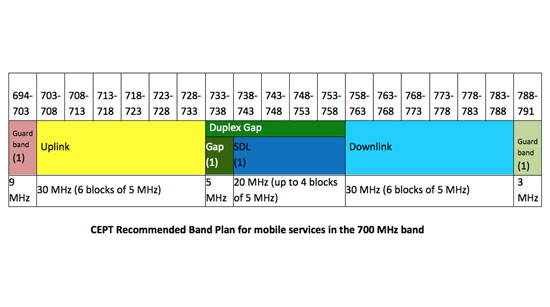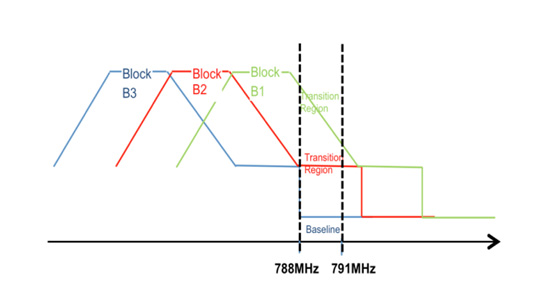Ready when needed: technical conditions for mobile broadband at 700 MHz band
Previously in our Newsletter, we set out how the European Commission had issued, in summer 2013, a mandate to the ECC to study the possible use of the 700 MHz range (694 to 790 MHz) for mobile (or 'wireless') broadband. This was against the background of a significant programme of work which we had already started to enable our preparation of coordinated positions for WRC-15. At the very least, the decision of WRC-12 to give this range co-primary status for mobile and broadcasting could change the dynamics of how countries apply the overriding Geneva 2006 agreement on the use of the UHF band for television and other services. This summer, the ECC completed two draft reports, CEPT Report 53 and ECC Report 221, on the issue; the CEPT Report will be finalised later this year, after a public consultation.
Throughout this process, the ECC has recognised that wireless broadband demand runs side-by-side with demand for terrestrial television and also other services. A one-size-fits-all allocation approach is not appropriate, or at least, it would be premature for the foreseeable future. Likewise, the European Commission has been careful to point out that the mandate is designed to assist future harmonised use of the band for those countries that decide to allocate 700 MHz to mobile, instead of terrestrial TV, and it should not indicate a decision to force an identical approach throughout the EU. However, the technical incompatibility of broadcasting with mobile service uplinks in particular – co-channel exclusion zones can stretch for hundreds of kilometres – does bring significant pressures for some degree of European harmonisation.
Therefore the EC mandate was in no way pre-emptive, although the Commission has been clear that it is considering developing an EU-level political agreement. Accordingly, the ECC’s response to the mandate is technically driven, with the consideration to maximise strategic usefulness of the band, taking account not just of wireless broadband but other demands, notably PMSEi, PPDRii, and possibly machine-to-machine communications (M2M).
Channelling Plan
The core issue to address with the 700 MHz mandate work was the channelling plan. The adoption by the Asia-Pacific Telecommunity (APT) of a firm plan offers an opportunity for global harmonisation with significant economies of scale and consumer benefit. However, this plan does not fit neatly into the adjacent band constraints in Europe. These are not only the existing TV channels below 694 MHz, but also the 800 MHz mobile broadband band above 790 MHz, which is already harmonised and licensed in Europe, with EU member countries obliged to put the band to this use, within specific technical parameters. This effectively reduces the bandwidth available for the usual symmetrical channelling arrangement for mobile, compared with the APT basic plan.
However the ECC’s Project Team 1 (PT1), chaired by Didier Chauveau (France), the ECC group responsible for developing CEPT Report 53 in response to the mandate, considered that the global harmonisation benefits outweighed the relative disadvantage of only being able to accommodate 30+30 MHz of capacity. PT1’s thinking is also influenced by the fact that the necessarily large duplex gap of this symmetrical plan opens up some possibilities for efficient use overall. It is not only wireless broadband which can deliver benefits by using these attractive frequencies.
Another firm outcome of PT1’s work was to confirm 694 MHz as the preferred lower boundary of this range (WRC-12 has left this detail open, for resolution at WRC-15). The recommended band plan set out in draft CEPT Report 53 is shown in the figure below:
The large 20 MHz centre gap can offer additional capacity for supplementary downlink mobile broadband services. This would be a convenient way to address the very asymmetrical nature of much broadband wireless traffic; and the predictions of high growth in demand usually centre on asymmetric applications with more emphasis on download than upload (e.g. video content). Alternatives would be to use the band in whole or part for PMSE, or for some plan involving PPDR. The Commission mandate requested the ECC to take these demands into account in its plans, and this scenario does that.
However, the draft CEPT Report 53 does not recommend any one of these additional options above another, and envisages that the decision could be left to national process based on the applicable priorities in the country concerned.
Technical Conditions for Use
The other key part of the draft CEPT Report addresses the mandate requirements to define least restrictive technical conditions for wireless broadband services (under the umbrella of 'MFCN' – Mobile/Fixed Communications Networks). The main elements of this are the maximum transmitted power of base stations and mobiles, and the block edge mask (BEM) which they should respect in terms of spectral occupancy. This has become a standard way in the ECC to allow for flexibility in technology use over time, and to avoid being unnecessarily prescriptive in how the conditions are met; it is the outcome rather than the means of achieving it which is most important. The BEM's use is not limited to mobile/fixed networks, but in the interests of spectral efficiency its design is based on this assumption. But the Report also defines a BEM for supplementary downlink in the duplex gap.
The BEM also avoids unnecessary restrictions on channels further away from the band edge, restrictions aimed at protecting other services which are typically planned and regulated under a different regime and at another time.
Programme Making and Special Events
An important part of the CEPT Report in response to the mandate, was to set out technical conditions which would apply to PMSE equipment to avoid it interfering with MFCN. This indicated a significant possibility to deploy PMSE both in the band and the duplex gap. However, the main constraint would be where MFCN interferes with PMSE: just think of an artist 'crowd-surfing' at a concert while the smartphones in the crowd are transmitting!
Danish artist Mø makes a habit of crowd-surfing in her energetic performances. But festival organisers don’t like it for safety reasons, they aren't thinking of possible interference in a future frequency planning scenario! (Photo: BT/ Jonas Skovberg Fogh)
The ECC has also studied this in some detail (in PT1 and Project Team SE7). ECC Report 221 on this subject – also referenced in CEPT Report 53 − has just been published. The conclusion is that this frequency range could be very useful to the wider PMSE sector, although the constraints – the risks − may be too great for high quality professional applications.
What next from the ECC?
ECC Decision: Having brought CEPT Report 53 to the stage of public consultation, the ECC is now following up with two related strands of work. First, the provisions of the CEPT Report will be used to develop an ECC Decision, which will enable any country which has already decided to use 700 MHz for wireless broadband to do so in a harmonised way. Of course that would still be subject to the relevant coordination with neighbouring countries, which is a significant practical constraint, but a different issue. This harmonisation is mainly about giving clarity to manufacturers, and to other users in the sector.
PPDR: Second, at the time that PT1 was completing its work some ideas came forward for using guard bands and the centre gap of the 700 MHz channelling arrangement for a paired block of spectrum for PPDR use. The likely density of deployment of PPDR and its different dynamics compared with general public mobile services could make such an arrangement achievable with relatively little opportunity cost to other services, or constraints to PPDR. However, there would, at least in principle, be a risk of pre-emption of use of the band, including below 694 MHz. Also, this is only a partial response to the requirements for broadband PPDR identified in the ECC’s FM 49 group. Therefore, the ECC has resolved to study this but also other options which may be applied at a national level, including frequencies outside the 700 MHz range.
Mark Thomas
Director of the ECO
i Programme Making and Special Events. Here referring to wireless microphones.
ii Public Protection and Disaster Relief.



